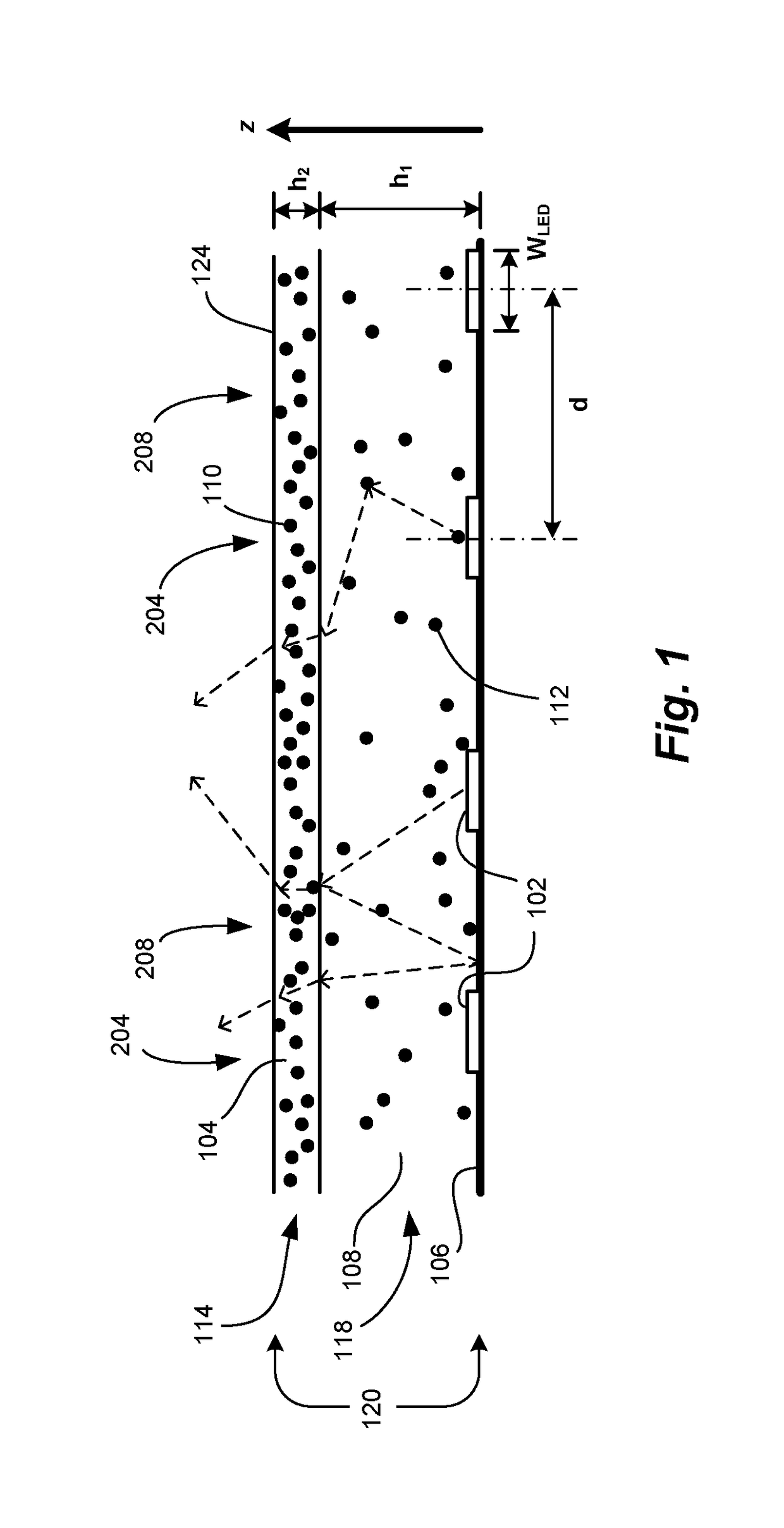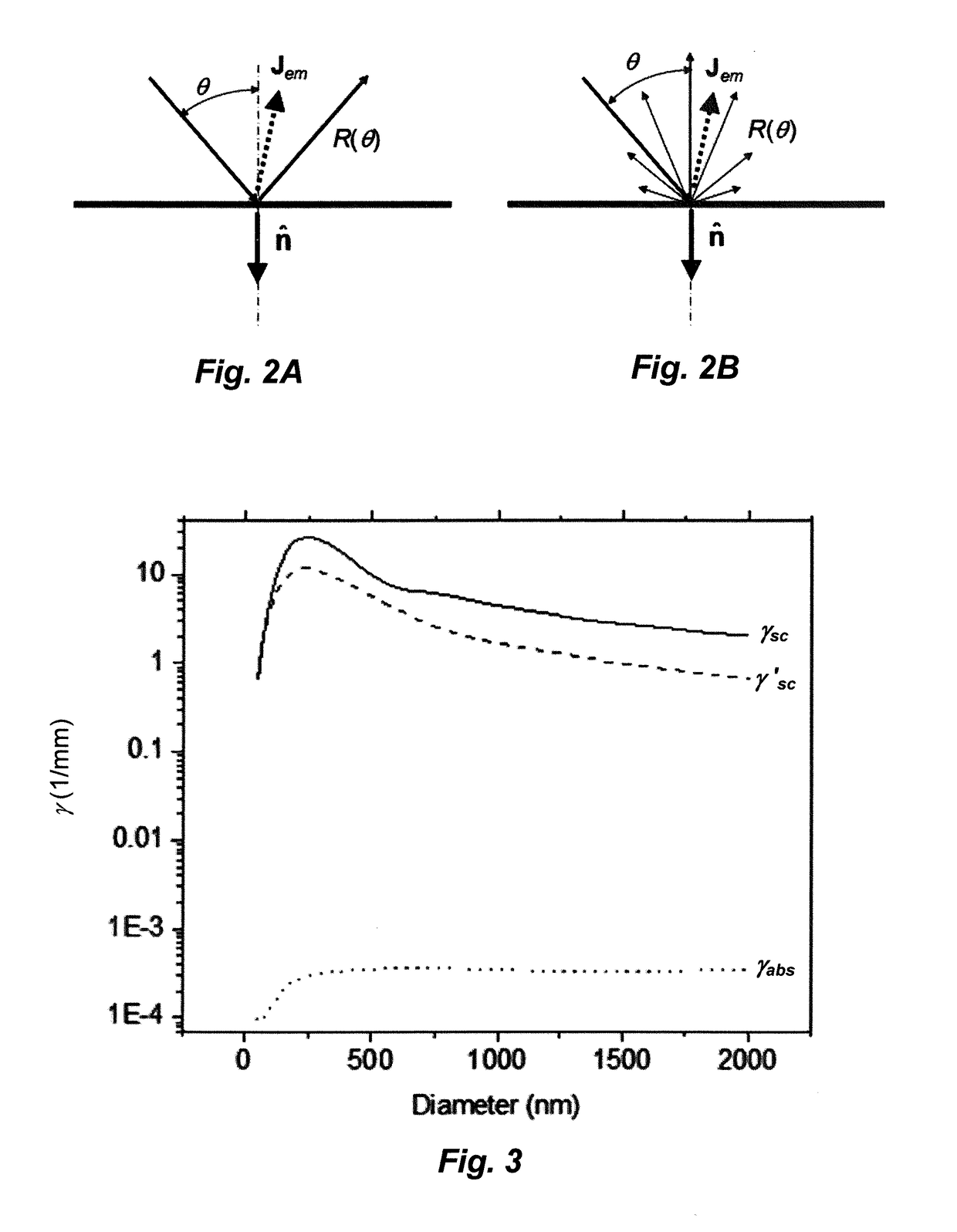LED light source with diffuser
a technology of led light source and diffuser, which is applied in the direction of basic electric elements, electrical equipment, and semiconductor devices, etc., can solve the problems of high glare, high cost, and high cost of leds, and achieves low cost, high efficacy, and uniform radiance distribution.
- Summary
- Abstract
- Description
- Claims
- Application Information
AI Technical Summary
Benefits of technology
Problems solved by technology
Method used
Image
Examples
example 1
yer Diffuser
[0056]In this Example, glare reduction is demonstrated using a single layer configuration. The layers in FIG. 1 are combined into a single homogeneous scattering layer. The host is silicone, preferably a methyl silicone, because of its lower optical absorption. Typical methyl silicone losses are on the order of 0.01 dB / cm at 633 nm and 0.03 dB / cm at 400 nm. This puts a worst case limit on the host absorption coefficient α−1, which would be used in Equation (10). For scattering centers, sub-micron titanium dioxide (TiO2) particles in the rutile form are excellent scattering centers because of their very high refractive index (˜2.6) and very high transparency in the visible.
[0057]Taking the index of refraction for a typical methyl silicone of 1.43, FIGS. 3 and 4 show plots of various scattering coefficients for TiO2 particles embedded in silicone. FIG. 3 shows the variation of the scattering coefficients γ′sc, γ′sc, and γabs versus mean diameter for a fixed mass loading RM...
example 2
Diffuser
[0061]In the second Example, a homogeneous two-layer approach (FIG. 1) in accordance with a preferred embodiment of this invention is used to further reduce glare and increase near-field uniformity. Simulations were made for a similarly thick stack: h1=4.5 mm and h2=0.5 mm. In this simulation, the LED thickness was reduced; LEDs (with phosphor) were assumed to be 1 mm×1 mm×0.5 mm. The LED reflectance was also reduced slightly to RLED=0.87 to better match high-quality dies. Table 1 shows the parameter range used; only the scattering coefficient of the lower diffusing layer 118 was changed. The corresponding TiO2 loadings ranged from 0.0043%-0.22%. For the upper diffusing layer 114 the corresponding TiO2 loading was approximately 0.22%.
[0062]Results show that when the lower diffusing layer 118 is low scattering, efficiencies and uniformity are very good and far better than the single layer approach as shown in FIG. 7 and Table 1. The lowest scattering coefficient for the lower...
example 3
Diffuser
[0064]One of the disadvantages of the two-layer configuration is the need for a thicker layer of scattering media. This can lead to excess weight, manufacturing time, higher probability of defects, and expense. To achieve a thinner layer with comparable glare reduction, uniformity, and efficiency, one can employ lateral variations (x-y plane orthogonal to the z axis) in the upper diffusing layer to reduce transmission of light above the LED region (FIG. 1, region 204) while having increased transmission of light away from the LED (FIG. 1, region 208).
[0065]A suitable scattering distribution in the upper diffusing layer to accomplish this is a two-dimensional (2D) radial Gaussian profile for the reduced scattering coefficient in the upper layer. We use the following form for simulations over the x-y plane:
γ′sc-2(x,y)=γ′0+(γmax−γ′0)e−(x2+y2) / 2σ2 (20)
Here, the distribution is determined by minimum and maximum reduced scattering coefficient values, γ′0 and γ′max, and a standard...
PUM
 Login to View More
Login to View More Abstract
Description
Claims
Application Information
 Login to View More
Login to View More - R&D
- Intellectual Property
- Life Sciences
- Materials
- Tech Scout
- Unparalleled Data Quality
- Higher Quality Content
- 60% Fewer Hallucinations
Browse by: Latest US Patents, China's latest patents, Technical Efficacy Thesaurus, Application Domain, Technology Topic, Popular Technical Reports.
© 2025 PatSnap. All rights reserved.Legal|Privacy policy|Modern Slavery Act Transparency Statement|Sitemap|About US| Contact US: help@patsnap.com



